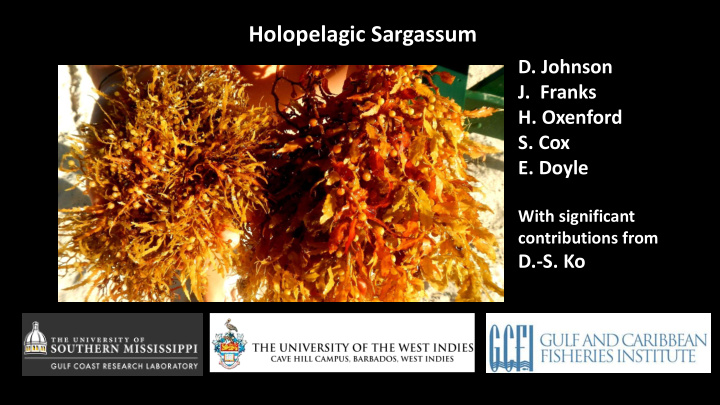



Holopelagic Sargassum D. Johnson D. Johnson J. Franks J. Franks H. Oxenford H. Oxenford S. Cox E. Doyle E. Doyle With data from With significant S. Cox contributions from C. Hu D.-S. Ko M. Wang
What is it? Brown macroalgae (seaweed) Pelagic: from classical Greek means open sea. Holopelagic: All of life is at sea. Clings (?) together in large mats and long lines. Can be ~1-2 m thick. Reproduces vegetatively – breaks and new growth. Provides a unique open sea ecosystem.
Pelagic Sargassum Fact Sheet E. Doyle and J. Franks What is it? Mitigating impacts on Fishers. Removing from beaches.
Where did it come from? NERR
Working Hypothesis Working Hypothesis During winter the NERR should ‘flush’ to the west/northwest. Exchanges between the east and west consolidation areas give several years gap in sargassum ‘leakage’ to the Caribbean.
Predicti Where did it come from? • Most likely from the North Atlantic in sufficient quantity (critical mass?) to ‘bloom’ in the NERR before winter current reversals and flushing occurs. • Once in the NERR it takes different routes from different bloom/consolidation regions to different parts of the Caribbean in different seasons.
Why Now? NAO: winds • Important Atlantic climate peaks (pos and neg) were coincidental and large in 2010-2011. • However, no ‘smoking gun.’ TNA: temperature • Non-linear bio-physical interaction due to large decadal scale climate oscillations may have played a role. AMM: equatorial dynamics • African dust? Iron, manganese and changing ocean PH.
What are the negative Impacts? • Tourism and Health • Shore ecology • Turtle nesting • Damage from removal • Coral Reefs • Sea grasses • Turtle and porpoise drowning • Fisheries
Sierra Leone, Andrew Huckbody Diane Wilson
South Coast, Barbados, - July 2017 Biological Impact of Sargassum on the coast. Before After Sargassum Sargassum Hazel Oxenford Brigitte Gavio Mustique – July 2014 Radio Grenadines
Catch of Flyingfish Flyingfish 1994-2017 Barbados 56.25 % June 2011 decrease Red line indicates first report of Sargassum event at Barbados. Horizontal dashed lines are mean catch before and after June 2011. Flyingfish use Sargassum to attach egg masses. Flyingfish being replaced by Almaco Jacks in the fisheries. 2018 Dolphinfish are juveniles.
Take away messages • It is very doubtful that the Sargasso Sea simply expanded its territory. The NERR appears to be a separate consolidation and bloom area that was seeded by the Sargasso Sea. • The new area extends across the Atlantic from Brazil to West Africa. Sargassum on the coastline is not just a ‘Caribbean’ problem. • It is not clear, but the NERR bloom possibly began with a combination of coincidental climate conditions and biological responses. • Coastal ecosystems are seriously harmed by massive invasions of pelagic Sargassum . • Offshore fisheries (fish and fishers) can be harmed or enhanced, but certainly changed .
Management response (from Emma Doyle) The response to the sargassum influx has often been a knee-jerk reaction - uncoordinated and not always environmentally sustainable. Local agencies need to agree on where and when it’s justified to take action to clean beaches or collect sargassum and how to dispose of it. Although various new approaches are evolving to manage sargassum in-water, they are costly, challenged by real marine and coastal conditions, and have at best mixed results. Good communications between agencies and the private sector, with the press, and with locals and visitors is essential.
Recommend
More recommend